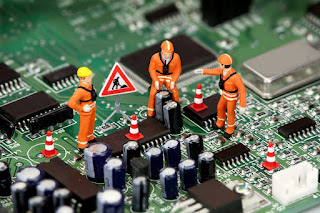introduction operating system
introduction operating system
An operating system (OS) is a collection of software that manages computer
hardware resources and provides common services for computer programs.
The operating system is a vital component of the system software in a
computer system
Application programs usually require an operating system to function.
For hardware functions such as input and output and memory
allocation, the operating system acts as an intermediary between
programs and the computer hardware
Examples of popular modern operating systems include Android, BSD, iOS,
Linux, Mac OS X, Microsoft Windows,[3] Windows Phone, and IBM z/OS. All
these, except Windows and z/OS, share roots in UNIX.
This is the interface between the user of a computer system and the
hardware. A basic functional definition is that it is a program that
makes the computing power available to users by controlling the
hardware
operating system
device management
It deals with the devices such as motherboard , mouse , keyboard , CD/DVD rom,
Memory Processor
storage management
Disk storage is only one of the memory types that must be managed by the
operating system, and is the slowest. Ranked in order of speed, the types of
memory in a computer system
user interface
The user interface is one of the most important parts of any program because it
determines how easily you can make the program do what you want. A powerful
program with a poorly designed user interface has little value. Graphical user
interfaces (GUIs) that use windows, icons, menus and Pointers have become
standard on personal computers.
house keeping
This includes all the functions below:Creating a file system : Copying, deleting,
moving files : Multitasking programmes : Starting the computer : Interfacing with the
hardware Programme intercommunication :Networking
Note that the Operating System has 2 main parts, the main O/S and the
Kernel (heart of the program).
DOS: (Disk Operating System) was developed by Microsoft. IBM also has its own
version. It is a single tasking O/S, command line oriented and not user friendly. It is
now been discontinued after version 6.22.
Windows:
Windows is today the most popular O/S for businesses and home PCs particularly. This
is because it is very user friendly, easy to use and has encouraged numerous people to
use the computer. It allows you to do more than one thing at a time and has a stylish
and easy to use GUI (graphical user interface). It even makes it easy for PCs not running
its network versions to easily share resources in a peer-to-peer manner.
Windows has several flavours including:
Windows 3.0 – 1st version of windows, highly dependent on DOS for its O/S
functionality
Windows 3.11- same as 3.0 but built with workgroup networks in mind
Windows 95 – very first window full O/S
Windows 98 – in improved version of Windows 95 with more utilities
Windows millennium edition – home and multimedia version of win98 with even more
utilities
Windows 2000 professional – a stable and security conscious version designed for
professional use.
Windows 2000 server – a network version of windows 2000 with support for more file
systems
Windows data centre – a massive version of windows 2000 server
Windows XP – the latest version of windows
Windows NT - the 1st network version of windows with support for up to 256 users per
NT server. NT is an acronym for new technology.
Linux: a Unix based O/S best described as the G.U.I. version of Unix. It is more users
friendly than it parent O/S and employs HCI’s metaphors a greater deal. Like
windows it allows you to perform more than one task at a time.
Unix: an advanced O/S more suitable for network use. Unix is popular among large
organisations particularly those with I.T. background. It is the best multi-user,
multitasking O/S with extensive stability. Most web servers still utilises Unix. It has
support for a wide range of software. Unfortunately it works like DOS being
command line based.
O/S 2: This is IBM’s O/S in the late 70’s. It is similar to DOS but was discontinued
rather quickly.
Mac: The Mac O/S is only used in Macintosh computers. It is user friendly with
support for high graphics handling. It is also suitable for multitasking. Mac is now up
to V08 O/S.
Types of operating systems
Real-time
A real-time operating system is a multitasking operating system that aims at
executing real-time applications.
Multi-user
A Multi-user operating system allows many different users to take advantage of
the computer’s resources Simultaneously.
Unix, windows 2000 and Family , Linux are operating system
Single user and multitasking
This is the type of operating system most people use on their desktop and laptop computers
Today.
Windows 98 and MacOS
Single user single task Dos is the example
made by pankaj
YouTube joint
YouTube joint
subscribe us :-https://www.youtube.com/channel/UCmNmmYpP2-CkGsW8hHWuNCw



Comments
Post a Comment